The “Style Pyramid” is related to a common rule of thumb in business called the “Pareto Principle” or the 80/20 rule that makes a basic observation:
In most events, 80% of the perceivable effects come from 20% of the known causes.
In other words, in just about every system there are only a few tangibles that are really driving things. The rest make small, localized differences. They matter – but don’t do most of the work.
In fashion, there are three qualities that drive nearly all of your wardrobe’s effects on your appearance: Fit, Fabric, and Function.
These three make up the “Style Pyramid” – The characteristics that define a garment, for better or worse. They’re where you’re getting the most “bang for your buck” in your clothing purchases.
Let’s go over these in more detail.
1. The Style Pyramid – Fit
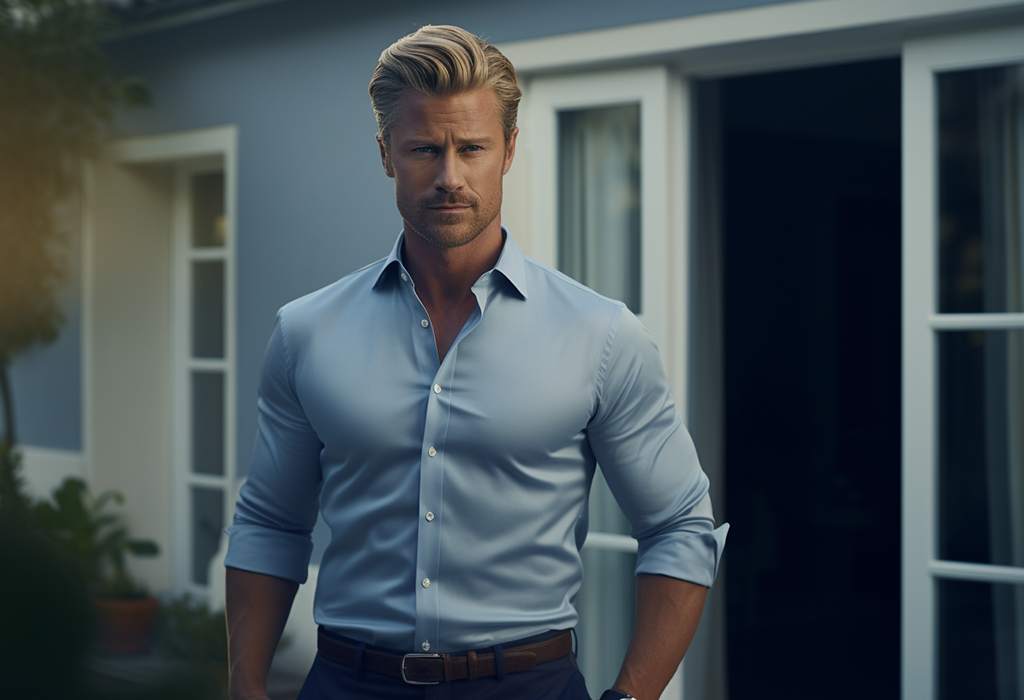

Out of all three aspects of the Style Pyramid, Fit is perhaps the most critical.
A good fit is one that doesn’t just slide onto the body without discomfort — it’s one that’s tailored to flatter your frame, emphasizing the features you want to draw attention to and minimizing the ones you want to conceal.
Lengths Of Your Garment
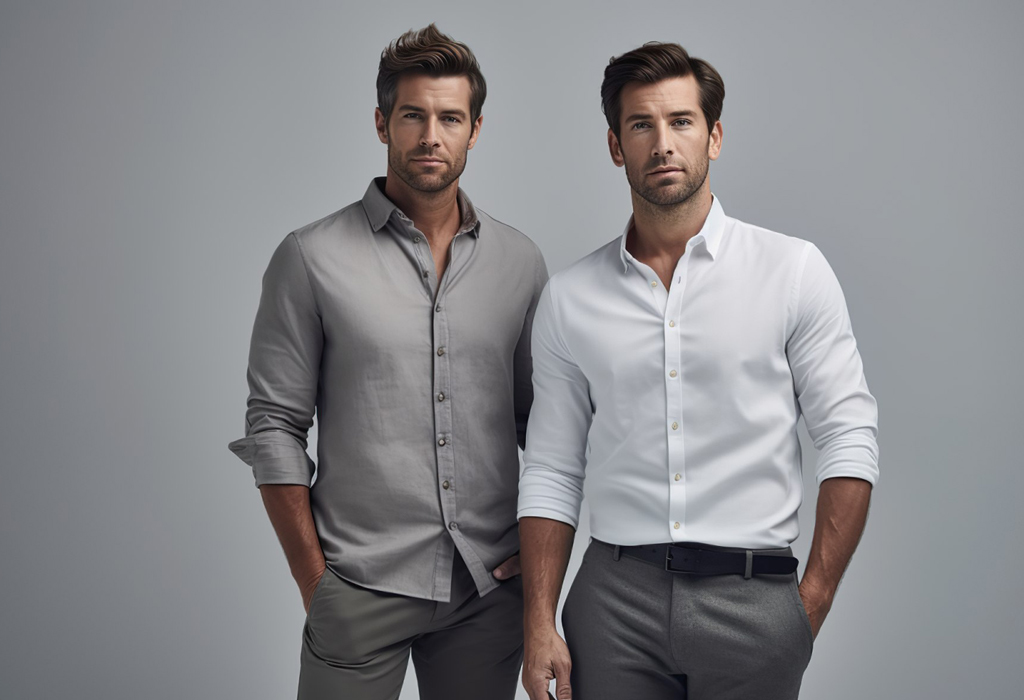

The easiest bad fit to spot is one where the garment is either too short or too long. Sleeves and trouser cuffs are the most common places for a bad length, but the hems of shirts and jackets can be a concern as well.
In general, clothing should stick to the following guidelines:
Trouser cuffs should brush the tops of the shoes they are worn with.
Shirt cuffs should cover the large bone on the upper outside of the wrist when the arms are slack.
Shirt tails should tuck at least an inch into the trousers they are worn with (two or more inches is preferable).
Cuffs should stop a half-inch or so shorter than shirt cuffs, usually at the base of the large wrist bone.
Jacket hems should fall far enough to cover the upper curve of a man’s buttocks when he is standing still.
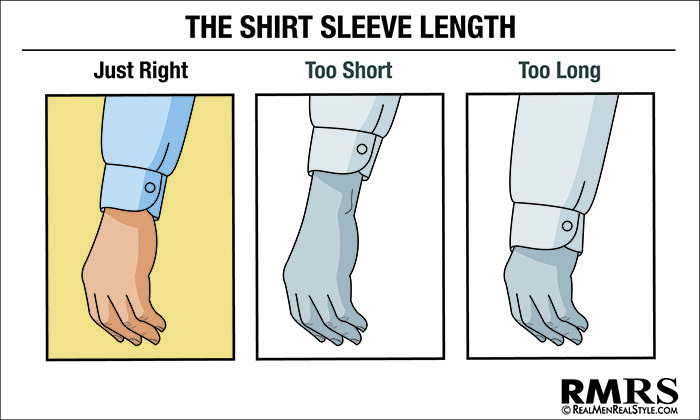

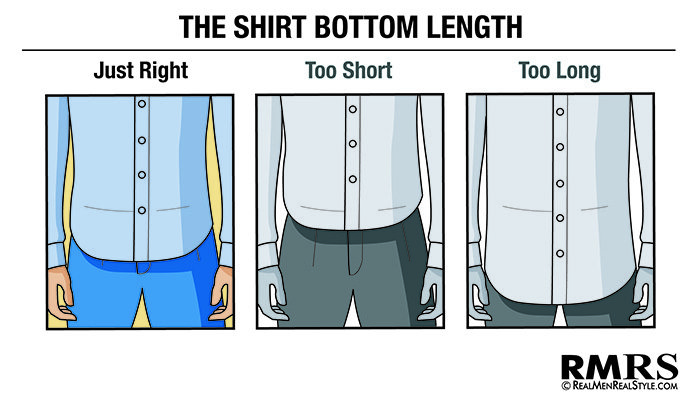

The Style Pyramid always allows some room for personal taste, but these are ideal guidelines for beginners. Anything that deviates substantially from them is a stylistic experiment that requires careful evaluation.
Width
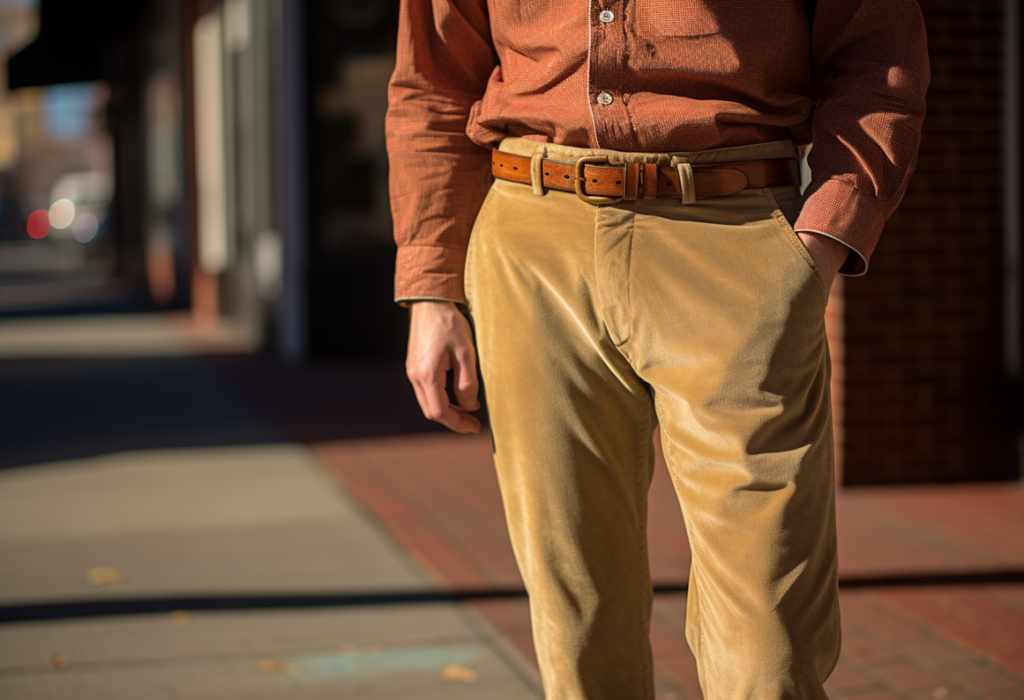

Different bodies need vastly different widths. This can be a problem when buying clothing in simplistic sizes like Small and Large. Many men need minor alterations to bring off-the-rack clothing within comfortable parameters.
Legs should taper slightly from the thigh to the ankle, following the thickness of the leg. They should not narrow and then widen again.
Waists should be tight enough that they cannot be taken on and off without unzipping the trousers. Waists worn with suspenders should be slightly looser than those worn with belts.
The crotch and seat of a pair of trousers should not hang more than a half-inch or so from the skin beneath. A little sag in the seat or crotch goes a long way toward making pants look bad.
Shirts should follow the contours of the chest – tapered toward the bottom for slender men; straight-sided for stout men.
Shirt cuffs should be just tight enough that they must be unbuttoned to remove.
Collars should touch the skin lightly (but not pinch) when the collar button is fastened.
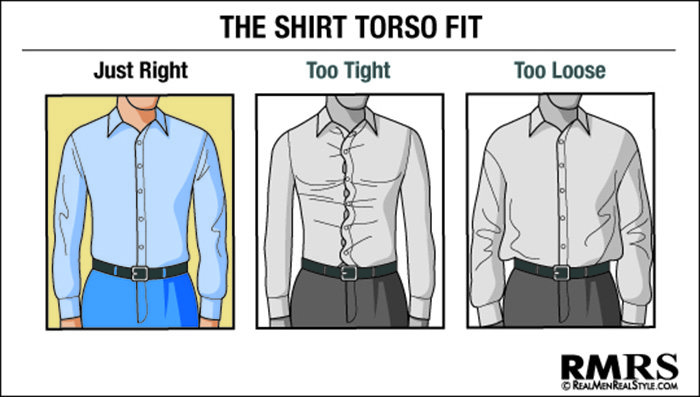

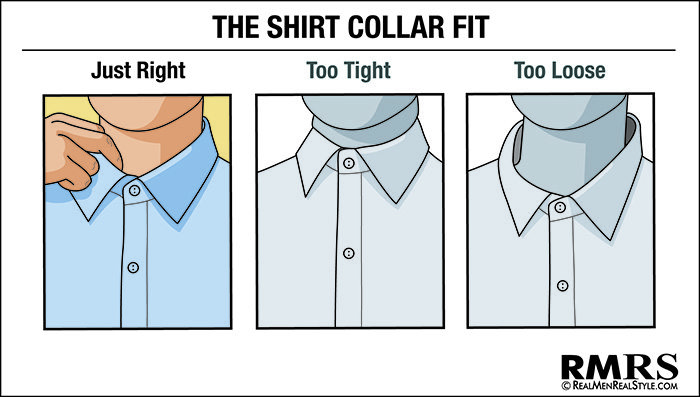

The shoulders of a jacket should end precisely where the shoulder of the body turns downward into the bicep. The shoulder seam should not hang down the arm or end partway across the shoulder.
Jackets may taper at the waist or fall straight, but in either case, they should button without hanging loosely off the torso or strained taut.
You can usually get a good sense of whether or not a garment’s width is correct just from how it feels to wear it.
If the fabric is pinching and wrinkling because it’s being stretched too far or swaying because it’s hanging too loose, it’s going to need adjustment.
A fit that is too tight or too loose is uncomfortable as well as unsightly and should be your top priority to fix.
2. The Style Pyramid – Fabric


When you buy a custom-made suit, most tailors will set their price based on the fabric you select. This should give you an idea of how important fabric selection is. It’s the most fundamental aspect in a garment’s construction.
The fabric used can affect many things about a garment including its weight and texture – but also the way it drapes on the body, the way it feels after hours of prolonged wear, and the care it requires.
Most menswear is made of either wool or cotton. You should familiarize yourself with the highest-quality properties of both.
Wool
Sheep’s wool is the staple material for men’s suits, jackets, and dress trousers. It comes in thousands of different weights and weaves, and can be set to many different purposes.
Wool is warmer than cotton and has a smoother drape over the body. It’s also more expensive to produce and requires more careful cleaning and maintenance.
Suits, jackets, and trousers made from wool are usually measured with a two or three-digit “fineness.” The smoothest worsteds, called “superfines,” range into the high $100s, while sturdier suits tend to fall between $70-$100. Anything over $150 is getting into the luxury item territory and may be too prone to creasing and damage for practical day-to-day wear.
Cotton
Some very casual items like T-shirts and sweatshirts are made from knit cotton rather than woven, which creates a looser, softer, and more shapeless garment.
Cotton is sometimes measured with a “thread count,” but the number is often inaccurate or misleading. The “handfeel” of a shirt is a more accurate judge of how it will actually feel on the body.
Men’s dress shirts and more casual trousers are usually made from woven cotton fabrics.
The best shirts are 100% cotton, preferably “longstaple” cotton (Sea Island, Pima, and some Egyptian cottons qualify). Wrinkle-free treatments can make them more convenient for travel, but may also make them stiffer and less comfortable. Visually, the best look is always going to come from an untreated but well-pressed cotton shirt.
Synthetics
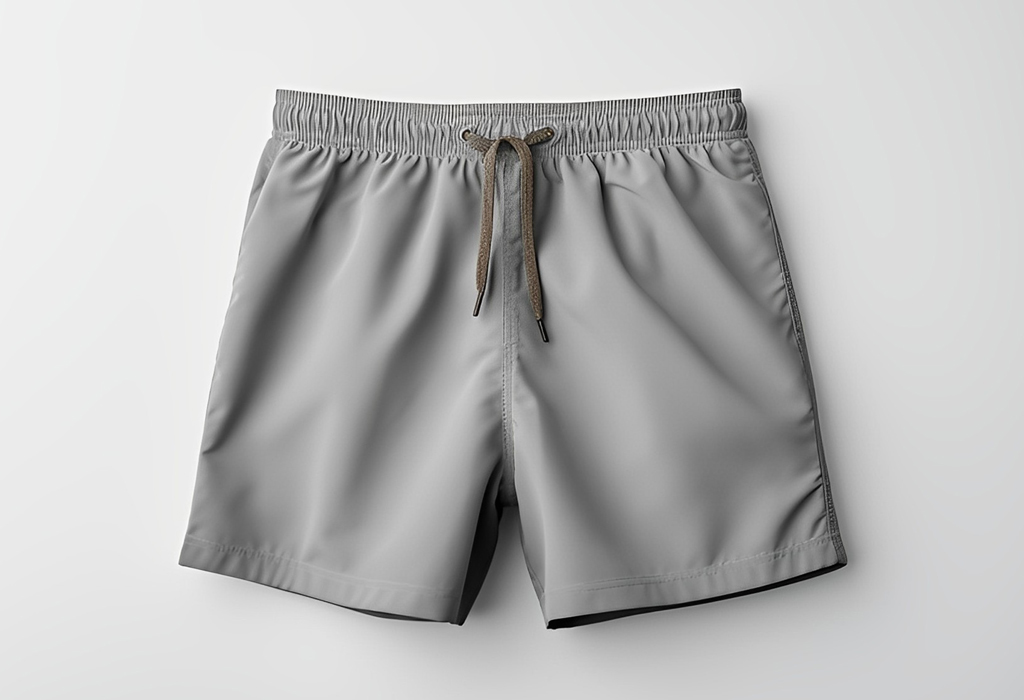

Ever consider how synthetic fibers figure into a man’s wardrobe? Nylon is fine for shell jackets, and polyester can make an acceptable casual shirt, but your best-looking clothing should be made from cotton and wool.
Most man-made fabrics do not make flattering clothing.
The exception is wool or cotton blends that incorporate a very small amount of a mildew-resistant synthetic for extra durability. These should still have the same form-flattering drape of the natural fiber, so long as the artificial fibers make up no more than a percent or two of the blend at most.
3. The Style Pyramid – Function


This cornerstone is the most straightforward of the trio. Take a look at your outfit, then consider its purpose.
Is it meant to be formal, business casual, or versatile casual? Is this the right uniform for the job?
Clothing should act as a tool to enhance your ability to achieve your immediate goals. How can this fail? Say you’ve overdressed for a casual networking lunch. You might look impeccable, but it’s likely that fewer people will approach you and many might find you pretentious.
Even if you master the rest of the Style Pyramid, you still need to make sure the clothing you’ve invested in is appropriate for you and the message you want to send to the world. Whether it be for a job or a hobby, you need to zero in on those characteristics you want to show through in your outfit.
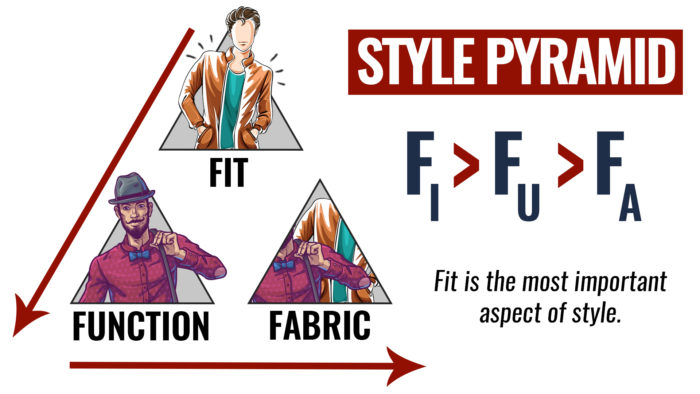

To summarize gents, you can’t shirk on any of the three Style Pyramid cornerstones. Fit determines how well your garments compliment your body type, Fabric can have implications for the maintenance and funds required, and Function represents the purpose of your investment.
Ideally, all of these would receive equal treatment. However, if you have limited resources and need to prioritize, go by our order (Fit>Function>Fabric). Once you learn these, you’ll be a master of menswear.
Click Here To Watch The Video – The Style Pyramid